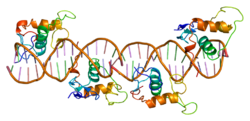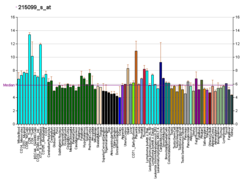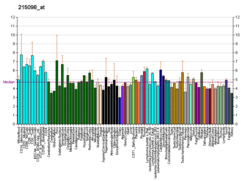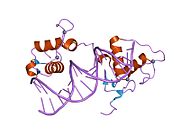
In the field of molecular biology, the peroxisome proliferator-activated receptors (PPARs) are a group of nuclear receptor proteins that function as transcription factors regulating the expression of genes. PPARs play essential roles in the regulation of cellular differentiation, development, and metabolism, and tumorigenesis of higher organisms.
The thyroid hormone receptor (TR) is a type of nuclear receptor that is activated by binding thyroid hormone. TRs act as transcription factors, ultimately affecting the regulation of gene transcription and translation. These receptors also have non-genomic effects that lead to second messenger activation, and corresponding cellular response.

The vitamin D receptor (VDR also known as the calcitriol receptor) is a member of the nuclear receptor family of transcription factors. Calcitriol (the active form of vitamin D, 1,25-(OH)2vitamin D3) binds to VDR, which then forms a heterodimer with the retinoid-X receptor. The VDR heterodimer then enters the nucleus and binds to Vitamin D responsive elements (VDRE) in genomic DNA. VDR binding results in expression or transrepression of many specific gene products. VDR is also involved in microRNA-directed post transcriptional mechanisms. In humans, the vitamin D receptor is encoded by the VDR gene located on chromosome 12q13.11.
The retinoic acid receptor (RAR) is a type of nuclear receptor which can also act as a ligand-activated transcription factor that is activated by both all-trans retinoic acid and 9-cis retinoic acid, retinoid active derivatives of Vitamin A. They are typically found within the nucleus. There are three retinoic acid receptors (RAR), RAR-alpha, RAR-beta, and RAR-gamma, encoded by the RARA, RARB, RARG genes, respectively. Within each RAR subtype there are various isoforms differing in their N-terminal region A. Multiple splice variants have been identified in human RARs: four for RARA, five for RARB, and two for RARG. As with other type II nuclear receptors, RAR heterodimerizes with RXR and in the absence of ligand, the RAR/RXR dimer binds to hormone response elements known as retinoic acid response elements (RAREs) complexed with corepressor protein. Binding of agonist ligands to RAR results in dissociation of corepressor and recruitment of coactivator protein that, in turn, promotes transcription of the downstream target gene into mRNA and eventually protein. In addition, the expression of RAR genes is under epigenetic regulation by promoter methylation. Both the length and magnitude of the retinoid response is dependent of the degradation of RARs and RXRs through the ubiquitin-proteasome. This degradation can lead to elongation of the DNA transcription through disruption of the initiation complex or to end the response to facilitate further transcriptional programs. Due to RAR/RXR heterodimers acting as subtrates to the non steroid hormone ligand retinoid they are extensively involved in cell differentiation, proliferation, and apoptosis.
The retinoid X receptor (RXR) is a type of nuclear receptor that is activated by 9-cis retinoic acid, which is discussed controversially to be of endogenous relevance, and 9-cis-13,14-dihydroretinoic acid, which is likely to be the major endogenous mammalian RXR-selective agonist.

The liver X receptor (LXR) is a member of the nuclear receptor family of transcription factors and is closely related to nuclear receptors such as the PPARs, FXR and RXR. Liver X receptors (LXRs) are important regulators of cholesterol, fatty acid, and glucose homeostasis. LXRs were earlier classified as orphan nuclear receptors, however, upon discovery of endogenous oxysterols as ligands they were subsequently deorphanized.
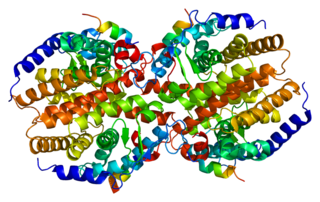
The constitutive androstane receptor (CAR) also known as nuclear receptor subfamily 1, group I, member 3 is a protein that in humans is encoded by the NR1I3 gene. CAR is a member of the nuclear receptor superfamily and along with pregnane X receptor (PXR) functions as a sensor of endobiotic and xenobiotic substances. In response, expression of proteins responsible for the metabolism and excretion of these substances is upregulated. Hence, CAR and PXR play a major role in the detoxification of foreign substances such as drugs.

The nuclear receptor co-repressor 1 also known as thyroid-hormone- and retinoic-acid-receptor-associated co-repressor 1 (TRAC-1) is a protein that in humans is encoded by the NCOR1 gene.

The nuclear receptor 4A2 (NR4A2) also known as nuclear receptor related 1 protein (NURR1) is a protein that in humans is encoded by the NR4A2 gene. NR4A2 is a member of the nuclear receptor family of intracellular transcription factors.

RAR-related orphan receptor beta (ROR-beta), also known as NR1F2 is a nuclear receptor that in humans is encoded by the RORB gene.

Retinoid X receptor alpha (RXR-alpha), also known as NR2B1 is a nuclear receptor that in humans is encoded by the RXRA gene.

Retinoic acid receptor alpha (RAR-α), also known as NR1B1 is a nuclear receptor that in humans is encoded by the RARA gene.

Liver X receptor alpha (LXR-alpha) is a nuclear receptor protein that in humans is encoded by the NR1H3 gene.

Retinoid X receptor gamma (RXR-gamma), also known as NR2B3 is a nuclear receptor that in humans is encoded by the RXRG gene.

COUP-TF1 also known as NR2F1 is a protein that in humans is encoded by the NR2F1 gene. This protein is a member of nuclear hormone receptor family of steroid hormone receptors.

Thyroid hormone receptor alpha (TR-alpha) also known as nuclear receptor subfamily 1, group A, member 1 (NR1A1), is a nuclear receptor protein that in humans is encoded by the THRA gene.

Retinoic acid receptor beta (RAR-beta), also known as NR1B2 is a nuclear receptor that in humans is encoded by the RARB gene.

Retinoic acid receptor gamma (RAR-γ), also known as NR1B3 is a nuclear receptor encoded by the RARG gene. Adapalene selectively targets retinoic acid receptor beta and retinoic acid receptor gamma and its agonism of the gamma subtype is largely responsible for adapalene's observed effects.
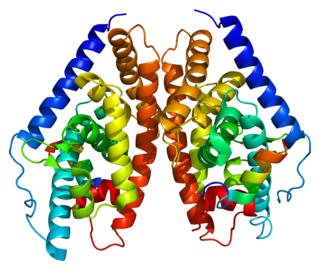
Liver X receptor beta (LXR-β) is a member of the nuclear receptor family of transcription factors. LXR-β is encoded by the NR1H2 gene.
Vitamin D response element (VDRE) is a type of DNA sequence that is found in the promoter region of vitamin D regulated genes. This sequence binds the vitamin D receptor (VDR), when complexed with calcitriol (1,25(OH)2D), the active form of vitamin D, and so regulates the expression of many genes.
